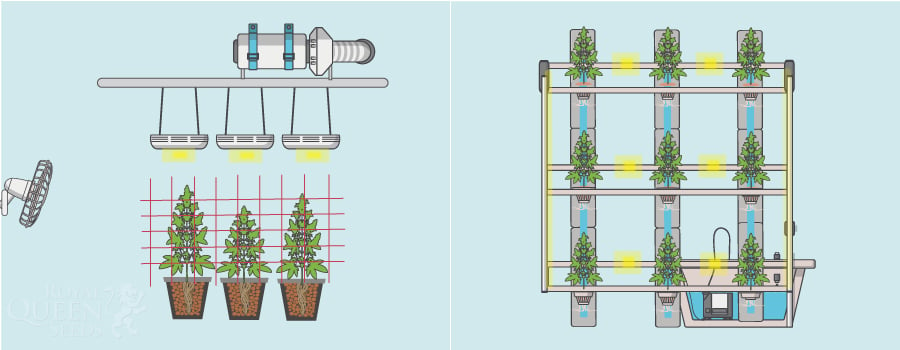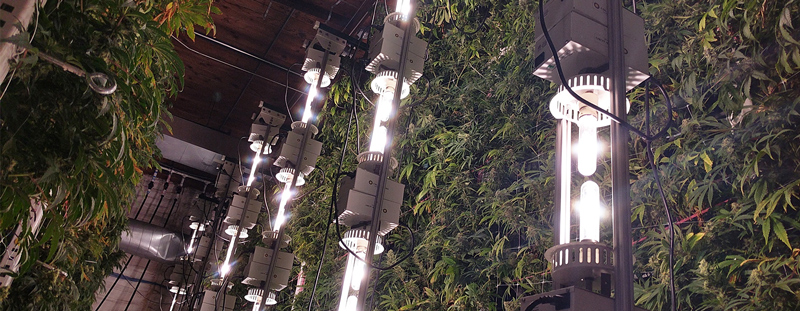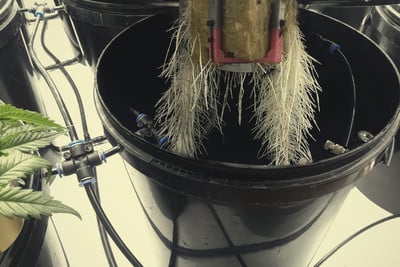.

What Is Vertical Cannabis Cultivation?
Vertical cannabis cultivation is not suitable for everyone, as it's much more hands-on, and potentially more expensive to set up too. However, for those who have mastered the art of horizontal cultivation and fancy a challenge, there's a whole new world of growing available.
Contents:
A vertical cultivation system might sound like the stuff of sci-fi, but it is real. Moreover, not only is it real, but it can be an incredibly efficient way to grow cannabis, maximising the amount that can be grown in a given space.
Though efficient, the vertical cultivation of cannabis can be considerably more complex than horizontal farming, and should be properly thought out before being attempted.
In this article, we explore different methods of vertical cannabis cultivation, and then provide some tips for those looking to try it themselves.
What Is Vertical Farming?
Vertical farming is the practice of not only using horizontal space in which to cultivate crops, but vertical space too. When you’re working with several metres cubed, you have a really large space to work with compared to working in the same area on a horizontal plane.
A vertical grow system is about fitting as much as possible into the space available to you. Ultimately, this leads to a greater yield per metre cubed.

What Are the Benefits of Vertical Farming for Cannabis?
Vertical cannabis grow systems allow growers to harvest much more bud from their space come harvest time. Really, this is the only significant benefit that vertical cannabis farming has over traditional horizontal methods of farming.
But if you have the space and want the yield, you shouldn’t underestimate how much of a benefit this is. In a small space, growers should at least be able to double their overall yield. And if you have a grow area with significant vertical space (say, where you can fit three or more plants) then you can achieve monstrous yields compared to if you stuck to the ground.
Depending on which vertical methods you employ, you might see other benefits too. For instance, if you grow in a tower setup, then you will have a shortened vegetative phase, which means you can fit more crop cycles into a year. Second, as this is a hydroponic (or aeroponic) growing method, you can mist nutrients directly onto the roots, which is more efficient than feeding plants in soil.
What Are the Cons of Vertical Farming for Cannabis?
For many people, the cons may outweigh the benefits of a vertical system. While vertical systems allow growers to raise huge amounts of weed, it is much more hands-on and time-consuming compared to growing on the ground in soil.
One major downside of a vertical system is that they tend to take up a lot of space—which many people might not have.
Moreover, a tower system is a fairly technical hydro setup that requires a lot of work and care—and is liable to go very wrong if you make a mistake. However, a stacked vertical grow mitigates some of these issues.
Finally, lighting can be an issue if growing vertically. As higher plants will block overhead light, growers must use vertical light tubes to light all of their plants. As well as being more specialist and expensive, these are a whole new piece of kit. Those considering a vertical grow probably have at least a few harvests under their belts, which means they likely already own lights. A vertical grow will mean investing in a brand new setup.
Two Types of Vertical Growing Techniques for Cannabis
Though there are variations of each, there are two general ways to set up a vertical cannabis grow-op. One essentially stacks horizontal grows on top of one another (and is the simpler method), while the second embraces true verticality.
Stacked Vertical Growing Systems
A stacked setup involves creating a shelving system. Each shelf will hold cannabis plants, and the number of shelves will be determined by the height of your room and the final intended size of your plants.
This method is much more akin to normal growing, and can even be used alongside pots and soil. Given this, it’s the natural first step for those looking to get into vertical growing.
As you can’t hang lights with this method, you’ll need to buy vertical light tubes, which illuminate your plants from the sides. A benefit of this is that it’s easier to get even light coverage across an entire plant, rather than it being concentrated at the top.
Although this method can be kept rather basic, it certainly lends itself to at least a degree of automation—such as an automatic watering system. This is because you’re likely to have a fair amount of plants, and accessing them all could be difficult.

True Vertical Growing Systems
A true vertical grow, or tower grow, utilises a tall cylinder from which the plants grow. With this method, the plants are held on the side of the cylinder, and grow upward from there.
In almost all cases, this will be either a hydroponic or aeroponic setup, and will require the requisite care and attention.
Though expensive and complex to get started with, a tower grow can offer a very efficient means of growing, in terms of space. Once again, vertical lighting will be necessary if you choose to use this grow setup.

How to Vertically Cultivate Cannabis
Now that you know the two basic systems, we’ll give some pointers on how best to achieve good results if you choose to pursue this growing method.
Choose the Right Strain
Since you want to maximise your space and grow as many plants as possible with a preferably even canopy, the first important consideration is the type of strain you want to grow.
As with SOG setups, indica-dominant or hybrid strains are suited better for this growing style than tall sativas. You want short-growing, non-stretchy plants that don't overgrow their given space. Also, the flowering phase should be initiated as soon as possible to keep their height manageable. Furthermore, it is a good idea to opt for strains that are resistant to diseases, as they pose a common threat in vertical grows.
Plan Your Grow Room Accordingly
By this, we mean leave enough space around the racks for plumbing, air movement, and worker access. Of course, you want to maximise your yield and pack as many plants into a room as possible, but you should not forget that the room needs to be functional for you as a grower as well.
That means the grow trays must be removed regularly for cleaning and replacing purposes. If you don't leave enough space for these kinds of grower tasks, your vertical grow can become frustrating very quickly.
Pick the Correct Lighting System
You want a light that can penetrate your whole canopy evenly and at a close distance. While there exist several options for said lights, the best are definitely LED lights due to the very low amount of heat they emit. LEDs have the best light spectrum options (oftentimes adjustable) for the different growing phases of cannabis, and are just as powerful as other light sources. Sure, the initial cost is usually higher compared to HPS or MH lights, but LEDs are much more cost-effective in the long-run, saving you a pretty penny on your energy bill.
On top of that, as mentioned, you’ll need to choose lights that come as a vertical tube in order to achieve even coverage of all your plants.
Keep Your Water System Clean
As with all automated watering systems, reservoirs and pipes should always be kept clean to avoid the risk of salt buildup and the formation of bacteria. Moreover, you should replace all of the plumbing between the reservoir and spigots every few cycles to ensure a clean delivery of nutrients.
Additionally, you should plan how to manage your wastewater. Most of the time, floor drains will suffice to collect any runoff, but sometimes your setup may require pumps and holding tanks for the runoff. This point is often overlooked because it can be quite costly, but if you are unsure what watering system you should implement, get help from an experienced plumber that you trust.
Start Simple
If you've never done a vertical grow before, it is best to start slow and simple; you can always extend your operation later.
Using two tiers in the beginning should be enough to keep you busy. Usually, if you use more than two tiers, the grow will become much more difficult in terms of design and functionality. Three or more tiers will complicate your vertical grow and require much more advanced—and therefore costly—cooling and ventilation equipment. Finally, keeping it simple at first will ensure a much safer growing and working environment so that you can get the most out of your operation.
Should You Try Vertical Cannabis Cultivation?
There are two types of growers who should consider trying vertical growing: those who have mastered horizontal growing and want even bigger yields, and those who are fascinated by cultivation and want an extra challenge.
Whatever your reason, it’s important to be aware that, in most cases, adding verticality to your grow will make it a much more complex operation, and as such it will probably be more hassle than it’s worth, unless you already have some experience under your belt.









































